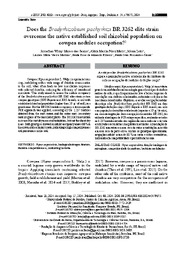Does the Bradyrhizobium pachyrhizi BR 3262 elite strain overcome the native established soil rhizobial population on cowpea nodules occupation?.
Does the Bradyrhizobium pachyrhizi BR 3262 elite strain overcome the native established soil rhizobial population on cowpea nodules occupation?.
Author(s): SANTOS, J. W. M. dos; PÉREZ MARIN, A. M.; LEITE, J.; MARTINS, L. M. V.; RIBEIRO, P. R. de A.; FERNANDES JUNIOR, P. I.
Summary: Cowpea (Vigna unguiculata L. Walp.) is a promiscuous crop, nodulating with a wide range of rhizobia strains native to the soil, what often leads to low inoculation responses with selected rhizobia, reducing the efficiency of introduced inoculants. This study aimed to assess the nodule occupancyof the Bradyrhizobium pachyrhizi BR 3262 elite strain in two cowpea genotypes (BRS Pujante and BRS Acauã), in soil with established rhizobial population (higher than 103 g-1 of soil), in a greenhouse. For the BR 3262 nodule occupancy, a strain-specific PCR approach was applied, assessing all the 1,237 nodules obtained from the root crown and the entire root (secondary roots) regions of the inoculated plants. The BR 3262 inoculation increased the root dry mass and nodulation, but not the shoot dry mass. Both genotypes showed a nodular occupancy above 80 % in the crown and secondary roots, indicating a high competitiveness and persistence in the soil.
Publication year: 2024
Types of publication: Journal article
Unit: Embrapa Semi-arid Region
Observation
Some of Embrapa's publications are published as ePub files. To read them, use or download one of the following free software options to your computer or mobile device. Android: Google Play Books; IOS: iBooks; Windows and Linux: Calibre.
Access other publications
Access the Agricultural Research Database (BDPA) to consult Embrapa's full library collection and records.
Visit Embrapa Bookstore to purchase books and other publications sold by Embrapa.

